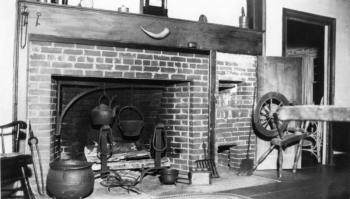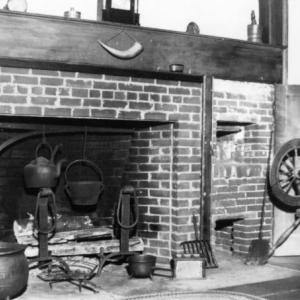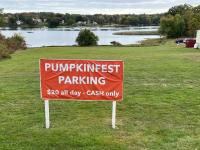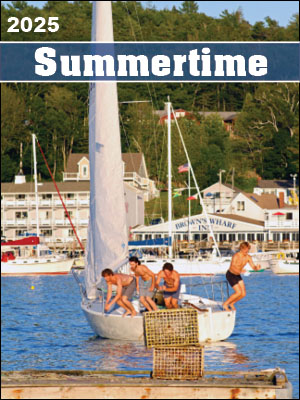Leach House: Step back in time on Sept. 13
Since the Boothbay Region Historical Society’s mission is to promote interest in the history of the Boothbay region, the upcoming evening on Sept. 13 from 4 to 6 p.m. at the Leach House on Sawyers Island will allow attendees a rare chance to step back in time.
In searching through the files at the Museum, I came across a Feb. 8, 1920 article from the Portland Sunday Telegram titled "OLDEST HOUSE NOW STANDING IN THE STATE."
I have retyped the article in its entirety to give a historical perspective of this historic house as Maine was celebrating its centennial. Look for more information on this historic house in the weeks ahead. Tickets for the event are $75 each with a limit of 75 guests. If you haven’t purchased your tickets yet, please do so online at www.boothbayhistorical.org or sending a check to Boothbay Region Historical Society, P.O. Box 272, Boothbay Harbor, ME 04538, indicating “Leach Party” in the memo.
We would like to recognize our “Event In-Kind Sponsor” Mine Oyster, “Event Sponsor” First Federal Savings & Loan, “House Tour Sponsors” Knickerbocker Group and Colby & Gale, and "Social Sponsors" Brady's Restaurant and Alan & Suzanne Cleveland for your support of this event.
Two Hundred Years of History Interwoven in Dwelling on Sawyers Island
Boothbay Feb.7. – In combing the Commonwealth of Maine in an effort to learn the whereabouts of the oldest dwelling, in connection with the 100th anniversary of the separation of the Pine Tree State from the Old Bay State, historians have found an ancient mansion which it has been claimed is the oldest house now standing within the confines of Maine.
The dwelling stands on Sawyers Island, one of the most picturesque islands on the Maine coast and overlooks the blue sweep of the Sheepscot. Two hundred years of history is interwoven about this building, which was evidently built by a person of wealth and refinement. Historians who have been digging into the archives have been unable to learn the name of the builder and have also been unsuccessful in establishing the exact date it was built.
John Patten came here from Newbury, Mass. in 1747, and bought the island of Samuel Barter, who lived on the island, and probably had squatter’s title only. In 1783 Sylvester Gardiner appeared as owner of the island, under a deed from the Kennebec proprietors, who obtained their title from the New Plymouth Patent, date January 13, 1629.
Sylvester Gardiner sold the island to Israel Davis, a noted Indian fighter, who had a license as an innholder on Sawyer’s Island, then known as “Ship’s” in 1762, in the old dwelling which was named in the deed of Samuel Barter 174 years ago.
In 1764 Davis mortgaged the island to Benjamin Sawyer and lived for a long period in the mansion, the island at that time taking his name, which it has since retained. In 1800 the old house again changed owners, and came into the possession of the Hodgdon family, who occupied it for some years, just how many, historians have been unable to determine. Charles R. Lewis of Portland bought the house in 1880, occupying it summers until 1910 with his family.
The dwelling is a square two-story building of the type of architecture common among the pretentious residences of two hundred years ago. The front room is large, as are the other rooms below, and the number of sleeping apartments on the second floor verify the supposition that the building was once a tavern.
There are big fireplaces in many of the rooms on the first floor and the elaborate wood work indicates that the builder was a man of means and artistic taste. The house is visited by many people, being of much interest because of its age, equally interesting to summer sojourners are the shell heaps near the wharf, now covered with grass, which indicate that the island, hundreds of years ago was the scene of ancient clambakes.
The “Indian kettles” are also objects of interest to city vacationists, who come to the coast. The kettles are hollowed from solid rock close to the rockbound coast and have long been a mystery to archaeologists. Near the kettles, and visible only at low tide is a wall of rock, extending across the entrance to the broad cove. People who have seen this wall and studied the way it is built, believe it dates back to some pre-historic race.
An old bed in the Sawyer mansion has for years attracted much attention. This bed was bought at Havana in 1860, in anticipation of a visit to Nassau, N.P. of Prince Alfred Ernest. Albert, Duke of Edinburgh, second son of Queen Victoria, and brother of King Edward VII. The sum of $125. was paid for this bedstead, and a room for his majesty’s use was furnished in the legislative council room of the court house building.
For two years after the visit of the Prince, the room was undisturbed, after which time everything was disposed of at auction, the bed later coming into possession of Antonio Lopez de Santa Ana, resident of Mexico at one time. Subsequently it was purchased by a Portland man and his daughter, who were in Mexico and learned its history. Eventually it made its way to the Sawyer mansion.




























